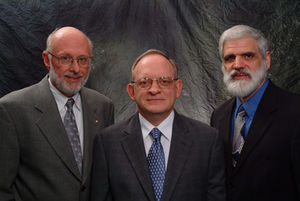Wayne Luplow
Biography
Wayne E. Bretl, Richard Citta and Wayne C. Luplow were key members of the team that developed the digital television transmission system adopted by the United States Federal Communications Commission (FCC) to replace the nation’s 65-year-old analog system.
Currently used by virtually every television station in the United States and South Korea, this groundbreaking digital technology provides both robust transmission and reduced interference. It is the technological heart of the millions of HDTV units now in use. As the transition from analog TV to digital TV nears completion in 2007, all sets made in the U.S. are expected to feature the new demodulation technology that takes a digital broadcast signal and turns it into the bitstream ultimately seen as a broadcast. The technology, which also allows utilization of previously unusable VHF and UHF TV broadcast channels, is expected to free up analog bandwidth for use in U.S. homeland security, public safety and other initiatives. In addition, the technology will allow new channels assigned to existing broadcasters to migrate to digital television.
Bretl, Citta and Luplow also were the technical advocates who shepherded the technology through the FCC’s grueling scrutiny and testing procedures as well as the regulatory process to incorporate the VSB-based digital TV standard into FCC requirements. Working together at Zenith Electronics Corporation in Lincolnshire, Illinois, the three electrical engineers and their colleagues developed the VSB characteristics to make high-definition television feasible in the harsh environment of terrestrial broadcast reception.
Their VSB modulation system employs unique technology to prevent interference into existing NTSC/analog broadcast signals. It also uses special methods to prevent interference from analog signals at 12dB and higher into the VSB signal. Bretl, Citta and Luplow also created a unique pilot signal to aid reception under adverse receiving conditions such as white or impulse noise and multipath impairments. The team repeatedly broke new ground, achieving 75 mile, low-power HDTV broadcast reception in one urban test and receiving digital HDTV signals with a simple bow-tie antenna in another. The lower peak power requirements of VSB operation allow stations on co-channels and adjacent channels to be located closer together without generating crippling amounts of interference.
More recently, they have worked to improve the adaptive equalization technology in DTV receivers and to develop enhancements to DTV standards to ensure against obsolescence.
An IEEE Fellow, Wayne Luplow is a vice president at Zenith Electronics Corporation. He is the editor of the IEEE Transactions on Consumer Electronics and is a member of the IEEE Consumer Electronics Society’s administrative committee. Luplow is a member of the Boards of Directors of both the Advanced Television Systems Committee (ATSC) and its sister organization, the ATSC Forum. He holds a bachelor’s degree from the University of Wisconsin in Madison and a master’s degree from the University of Pennsylvania in Philadelphia, both in electrical engineering.
